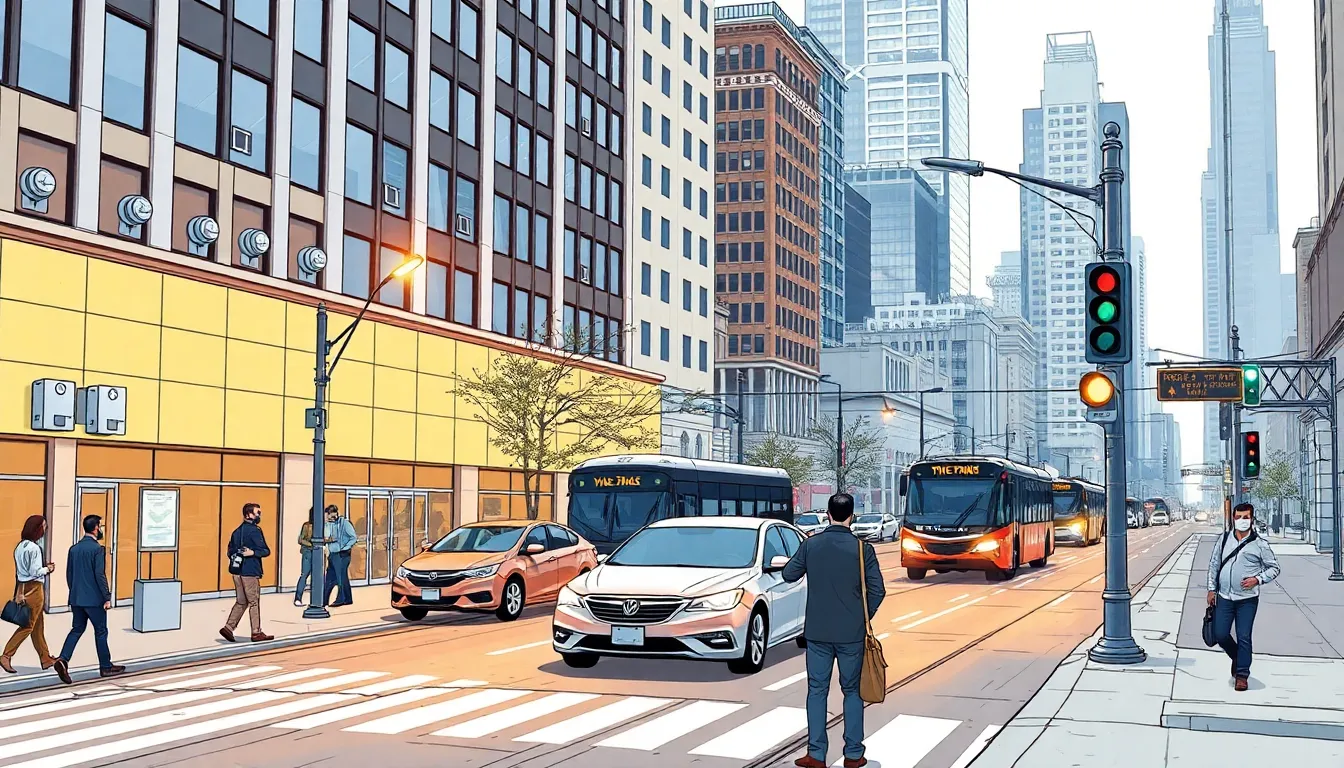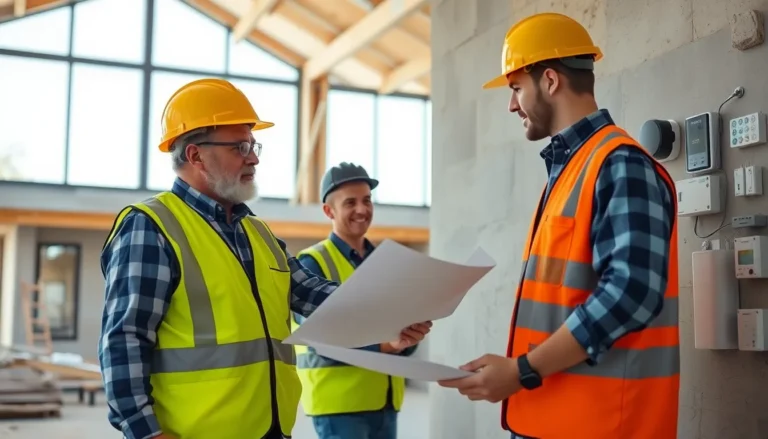Table of Contents
ToggleIn a world where even your coffee maker can talk back, smart infrastructure is the unsung hero of modern living. Imagine a city where traffic lights don’t just change colors but actually communicate with your car to make your morning commute a breeze. That’s not sci-fi; it’s the future knocking at your door, and it’s time to let it in.
Smart infrastructure is all about using technology to create efficient, sustainable environments. From energy-efficient buildings to intelligent transportation systems, this innovation isn’t just about making life easier; it’s about saving the planet while doing it. So buckle up as we dive into how these tech-savvy solutions are transforming our cities into smarter, greener, and more connected spaces. Who knew saving the world could be this fun?
Overview of Smart Infrastructure
Smart infrastructure involves integrating advanced technologies into urban and rural settings to enhance efficiency and sustainability. Innovations transform conventional structures into intelligent systems that interact seamlessly with their environment. Energy-efficient buildings utilize smart energy management, reducing consumption while maintaining comfort. Intelligent transportation systems improve traffic flow by providing real-time data to drivers, minimizing delays and enhancing safety.
Cities adopting smart infrastructure experience significant benefits. Enhanced connectivity leads to better communication among various systems, such as traffic lights and public transport. This networked approach facilitates a smoother daily experience for residents and visitors. Sustainable practices play a crucial role in these developments, prioritizing green technologies and renewable energy sources.
Smart sensors embedded in infrastructure monitor conditions, aiding maintenance and decision-making. These sensors collect data on factors like air quality, temperature, and energy use. The information guides urban planners in making informed choices for future developments. Smart infrastructure promotes resilience against climate change by enabling cities to adapt effectively to evolving conditions.
Overall, smart infrastructure lays the foundation for future urban landscapes. By focusing on technological integration, these systems create livable spaces that enhance quality of life. Sustainable growth becomes feasible, supporting both current and future generations. Embracing these innovations leads to a smarter, more connected world, where urban environments evolve to meet the needs of their inhabitants while fostering environmental stewardship.
Key Components of Smart Infrastructure

Smart infrastructure comprises several essential components that work cohesively to enhance modern urban environments. These components include IoT devices, data analytics, and connectivity solutions, all essential for creating efficient systems.
IoT Devices
IoT devices play a crucial role in smart infrastructure by enabling real-time monitoring and control of various systems. Sensors embedded in buildings, roads, and public spaces gather data on air quality, energy use, and traffic patterns. These devices communicate with each other, allowing for timely responses to changing conditions. Smart meters, for example, track energy consumption and help users optimize their usage. Additionally, connected vehicles leverage IoT technology to improve navigation and reduce congestion, creating a more seamless commuting experience.
Data Analytics
Data analytics transforms the data collected by IoT devices into actionable insights for urban planners and infrastructure managers. Analyzing trends in energy consumption, traffic flow, and environmental conditions helps identify areas needing improvement. Predictive analytics assists in anticipating maintenance requirements, minimizing downtime, and enhancing overall system resilience. Cities can leverage this data to implement sustainable practices and optimize operations, contributing to a more efficient urban landscape. Utilizing advanced analytics tools empowers decision-makers to create smarter, more responsive communities.
Connectivity Solutions
Connectivity solutions form the backbone of smart infrastructure, enabling communication between devices and systems. High-speed internet and wireless networks support the seamless data exchange that underpins smart technologies. Technologies such as 5G provide the necessary bandwidth for interconnectivity, allowing devices to transmit large amounts of data quickly. Enhanced connectivity improves service delivery, from traffic management to public safety alerts. Reliable communication networks foster collaboration among city services, ensuring that various components of smart infrastructure work in harmony to benefit residents.
Benefits of Smart Infrastructure
Smart infrastructure offers numerous advantages that enhance urban living and support sustainable practices. It significantly improves operational efficiency and reduces resource consumption through advanced technologies.
Enhanced Efficiency
Smart infrastructure streamlines operations across various systems. IoT devices facilitate real-time monitoring and control, optimizing traffic signals and energy use. Data analytics enables urban planners to make informed decisions, resulting in improved response times to changing conditions. Connectivity solutions, such as 5G technology, enhance communication among devices, minimizing delays in service delivery. Enhanced efficiency leads to reduced congestion and shorter commutes, benefiting residents and fostering a smoother daily experience.
Improved Sustainability
Sustainable practices become integral to design with smart infrastructure. Energy-efficient buildings employ smart energy management systems that reduce consumption while maintaining comfort. Environmental monitoring through embedded sensors collects data on air quality and energy usage, supporting climate resilience. Urban planners leverage this information to guide future developments, ensuring they prioritize green technologies and renewable energy sources. Improved sustainability not only conserves resources but also enhances the overall quality of life within urban environments.
Challenges in Implementing Smart Infrastructure
Implementing smart infrastructure faces significant challenges that can hinder its potential benefits. Understanding these obstacles is crucial for successful integration.
Technological Barriers
Outdated technology can impede the deployment of smart infrastructure solutions. Many existing systems lack compatibility with new advancements, making integration difficult. Security concerns arise as well, with data protection becoming increasingly critical. Inadequate cybersecurity measures risk data breaches, undermining public trust. Technical skills also play a role; a shortage of trained professionals limits the implementation of complex technologies. Adopting innovative data management solutions is essential for overcoming these technological challenges.
Financial Considerations
High upfront costs represent a significant barrier in implementing smart infrastructure. Budget constraints often limit city planners from pursuing comprehensive projects. Funding gaps can arise, as governments may hesitate to invest in long-term benefits without immediate returns. Operational expenses must also be considered, as maintaining advanced systems requires continuous investment. Competing financial priorities may divert funds toward other pressing infrastructure needs. Therefore, securing sustainable financing models and partnerships is critical to achieving successful implementations.
Future Trends in Smart Infrastructure
Emerging technologies continue to shape the landscape of smart infrastructure. Innovations in artificial intelligence (AI) and machine learning facilitate predictive maintenance, allowing cities to address issues before they escalate. Integration of 5G networks enhances connectivity, enabling faster data transfer between smart devices and infrastructure systems.
Urban planners increasingly prioritize sustainability in new projects. Use of renewable energy sources significantly reduces reliance on fossil fuels, supporting climate adaptation. Intelligent transportation systems evolve, with autonomous vehicles becoming a common feature in urban environments. Traffic congestion decreases as these systems optimize routes and improve public transportation efficiency.
Data analytics play a crucial role in future developments. Real-time insights from smart sensors influence decisions on energy use, traffic patterns, and public safety. Cities can adapt more quickly to changing conditions, enhancing the living experience for all residents.
Adoption of blockchain technology enhances security and transparency in transactions related to smart infrastructure. Companies utilize smart contracts, simplifying interactions while reducing the risk of fraud. Consequently, trust among stakeholders increases.
Collaboration among governments, private sectors, and communities is essential for success. Public-private partnerships provide funding opportunities and resources for implementing smart infrastructure projects. Sharing knowledge and expertise fosters innovation, driving forward the creation of interconnected urban environments.
As technology evolves, the focus on accessible infrastructure grows. Cities invest in inclusive designs that accommodate all residents, ensuring equitable access to services. Emphasis on user experience contributes to an improved quality of life, promoting community engagement and satisfaction.
Smart infrastructure represents a transformative shift in how cities operate and interact with their residents. By integrating advanced technologies and sustainable practices, urban environments can become more efficient and responsive to the needs of their inhabitants. The benefits extend beyond improved daily experiences to include significant contributions to environmental sustainability.
As cities embrace these innovations, they pave the way for a future where connectivity and efficiency are the norms. Overcoming challenges like technological barriers and financing will be crucial in realizing the full potential of smart infrastructure. With continued collaboration among stakeholders, the vision of smarter, more livable cities is within reach, ensuring a better quality of life for generations to come.





